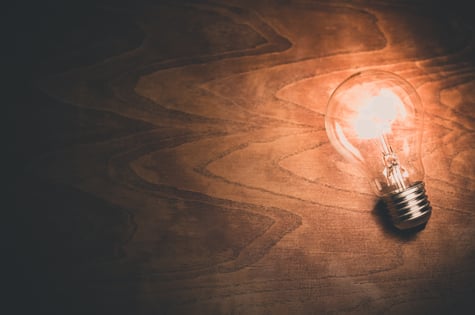
We frequently encounter buyers who want to know more about the lights they are choosing – not just how they look, but how they function, and what makes one lighting technology different from another. If you're looking for the most cost-effective way to light a building, or want to know what types of lighting feel the most natural to clients, you're in the right spot! We're creating a brief series on the nature of available. lighting technologies, starting with the grandfather of them all, the incandescent light.
Science of Incandescents
Incandescent lights use a filament – a thin wire of material with specific electrical resistance properties, suspended inside a bulb. When an electrical current is channeled through the filament via contact wires, it resists the energy and converts some of it into light (much like an electric oven's element converts electricity into heat).
Even today's filaments, which are made from tungsten and heated to around 4,000 degrees Fahrenheit, are delicate spools of metal. They are surrounded by sealed bulbs that prevent oxygen from reaching the filament and corroding it. However, even with the best protection incandescent filaments tend to burn out after a year or two, when the filament corrodes and breaks. This causes the classic "tinkling" sound of a dead bulb as pieces of the filament rattle around.
Brief History
As you may remember from history classes, incandescent light bulbs are often associated with Thomas Edison. However, Edison didn't so much invent the incandescent bulb as secure the American patent for it; a number of scientists across the world invented the basics of the incandescent bulb throughout the 1800s through trial and error.
Incandescents are regarded as the first true light bulb, the product that replaced oil and gas lamps and helped usher in the age of electricity. As time has passed, these bulbs have been made with better and better materials to help increase longevity. Today they can be found in table lamps, flashlights, overhead lighting and more.
Things to Consider
-
Heat and Energy
Incandescent bulbs are famous – or rather, infamous – for producing a lot of heat and taking a lot of electrical energy to power. They cannot be used near flammable materials, and are expensive for a business to operate. Compared to other lighting technologies, they are one of the least efficient options. -
Life Span
- Incandescent bulbs also have a very short life span compared to fluorescents and LED lighting, which means they need to be frequently replaced, adding to the cost.
-
Rebates and Green Projects
- It's worthwhile to look for rebates or green initiatives from your city, state, or federal government if you want to switch from incandescents to another form of lighting. Contact a lighting rep for more information about which rebate is right for you.
-
A Warm Appearance
- One reason to consider incandescent lights is that their high temperatures and unique materials provide a very "warm" and natural type of lighting. This lighting is useful for photography, bringing out organic qualities in products, and similar situations.
-
The Future of Incandescents
More energy-intensive incandescents, like 75 and 100-watt varieties, have been discontinued for years now. The 60 and 40-watt versions are also discouraged by federal restrictions. In short, incandescent bulbs are quickly fading to a novelty form of lighting. Unless aesthetics are very, very important in a certain area, there's not much commercial benefit to using incandescent lighting.
Be sure to check back in the coming weeks for parts 2 and 3 of this series about Waves of Lighting Technology.
Want to stay illuminated about LED lighting technologies? Be sure to sign up for weekly blog notificatons at the top of this page!



